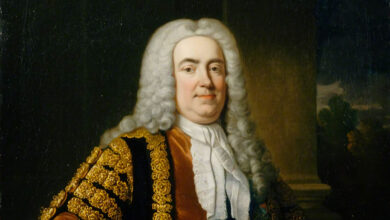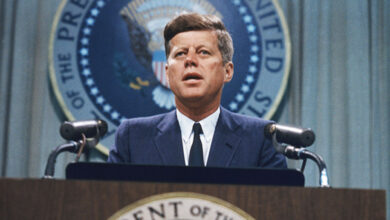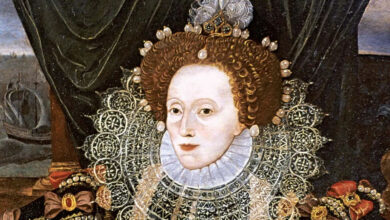“The secret of golf is to turn three shots into two.” – Bobby Jones
Podcast: Play in new window | Download
Subscribe: Spotify | Amazon Music | Youtube Music | RSS
Bobby Jones Biography
Robert Tyre Jones Jr. was born on 17 March 1902 in Atlanta, Georgia, USA to parents Clara Thomas and Robert Purmedus Jones. The Jones family spent their summer vacation time at the East Lake Country Club in Atlanta where Bobby became interested in golf and would mimic the club’s golf professional, Stewart Maiden. Year after year, and encouraged by his father, Bobby improved and when he was six years old he entered a children’s tournament at the club, which he won.
Bobby developed his golf skills quickly and at the age of only fourteen in 1916, he won his first major tournament, when he took part in the inaugural Georgia Amateur Championship. His victory put his name on the national list of players to watch out for and he was noticed by the U. S. Golf Association which invited him to play at the U. S. Amateur tournament at Merion, where he made it to the quarterfinals.
During his teens, as well as continuing to play with his father and with Maiden, Bobby also had lessons from Willie Ogg, a Scottish-American professional and course architect.
During the First World War, Bobby toured the United States and played a number of exhibition matches in aid of the war effort that were attended by large crowds of people. This experience stood him in good stead for when he later played in larger competitive tournaments.
In 1919 he travelled outside the United States for the first time to play golf when he represented the USA in an international team match against Canada at the Hamilton Golf and Country Club in Ontario, which the USA won. Whilst there, Bobby also played in the Canadian Open where he finished tied for second behind the winner J. Douglas Edgar who would become a mentor and coach to Bobby. The following year, whilst still only eighteen years old and by far the youngest player on the team he helped the United States repeat the win against Canada, this time when they hosted the event in Long Island, New York. Also in 1920, he played in his first U. S. Open, an event which he would go on to win only three years later.
One of the biggest constraints that Bobby Jones had to deal with during his playing career was his temper. He was a perfectionist and when things weren’t going his way, it showed. One of the worst examples was during the 1921 British Open when during the third round and after struggling down the front side, he picked up his ball, ripped up his score card and quit the round.
Over the 1922 and 1923 season, though, he went through an unbelievable transformation, re-emerging on the golf scene as a completely changed individual. Gone was the spoilt, club-throwing teenager, replaced by a calm, mild-mannered sports professional. So much so, that when during the 1925 U. S. Open he played a shot into the rough and subsequently moved the ball by accident when his club head brushed the grass, he called a penalty on himself which ultimately led to him losing the tournament.
In 1922 Bobby graduated from Georgia Tech with a B. S. in Mechanical Engineering and went on to earn a degree from Harvard in English Literature in 1924. Also in 1924, Bobby Jones got married to Mary Rice Malone who he had met whilst at Georgia Tech and the couple went on to have three children, Clara, Robert Tyre III and Mary Ellen. In 1926 he began attending Emory University School of Law and passed the Georgia Bar Exam after only three semesters, proving that his talents were not only associated with the golf course, and joined his father’s law firm.
In 1930 he became the only player to ever win all four major golf championships (pre-masters) in the same calendar year when he won The Amateur Championship at St. Andrews in Scotland, the Open Championship at the Royal Liverpool Golf Club, The U.S. Open in Minnesota and the U. S. Amateur at the Merion Golf Club. He was so confident that he could achieve the grand-slam as it was known, that before the first tournament he placed a bet on himself at odds of 50-1 and scooped $60,000.
Bobby Jones represented the United States in the Walker Cup no less than five times, captaining the team in 1928 and 1930, and only lost one of the ten matches he played winning the trophy with the U. S. on all five occasions.
In 1930, Bobby Jones retired from competitive golf at the age of twenty-eight. He wasn’t done with golf altogether, though, and giving up his amateur status, went on to make some serious money through a contract to film eighteen instructional golf films between 1931 and 1933. He also helped develop a set of steel-shafted matched clubs which sold well and are still considered to be one of the best sets of clubs ever designed.
At the height of his powers, Bobby Jones was arguably the most recognisable sports person in the world and it became increasingly difficult to maintain a sense of privacy when out on the golf course. So, after he retired he looked around for some land on which he could build a golf course so that he and his friends could play golf whenever they liked without being in the public eye. He eventually settled on a piece of land which had been an indigo plantation since the Civil War in Augusta, Georgia, called Fruitlands. He bought the land in 1931 for $70,000 and with the help of Alister McKenzie designed and built the Augusta National course which opened in 1933. The following year Bobby Jones founded the Masters Tournament, known then as the Augusta National Invitational which was first played in March 1934, coming out of retirement in order to promote the event by playing in it.
When the Second World War came along in 1939, Jones was keen to play his part and served as an intelligence officer in England with the rank of major with the 84th Fighter Wing, where he also met General Dwight D. Eisenhower and the two became friends, with the yet to be United States President using Bobby’s cottage at Augusta for golfing vacations. He took part in the invasion of Normandy in 1944 and spent two months as a prisoner of war interrogator, finishing his military service with the rank of Lieutenant Colonel. During his time away, he let the U. S. Army graze cattle on his land at Augusta.
After the war, Bobby continued to play in the Augusta National but by 1948 a deterioration in his health meant that this was no longer possible and he was eventually diagnosed with a rare fluid-filled cavity in his spinal chord called syringomyelia in 1956, which was extremely painful and eventually led to paralysis, confining Jones to a wheelchair. The Masters Tournament as it became known evolved into one of the most respected tournaments in the world and was jointly run by Jones and Clifford Roberts who served as Chairman of the club from 1931 until his death in 1976 when he was named Chairman in Memoriam.
Bobby Jones was named President in Perpetuity by the governing board and membership of the Augusta National in 1966.
Bobby Jones suffered an aneurysm and died on 18 December 1971 at the age of sixty-nine. At his own request, the funeral was small and private. He was buried in Oakland Cemetary in Atlanta.
Bobby Jones was inducted into the World Golf Hall of Fame in 1974 and his greatest legacy is his unmatched sportsmanship and professionalism but also the Masters Tournament, one of the most prestigious golf tournaments in the world.
Podcast: Play in new window | Download
Subscribe: Spotify | Amazon Music | Youtube Music | RSS




